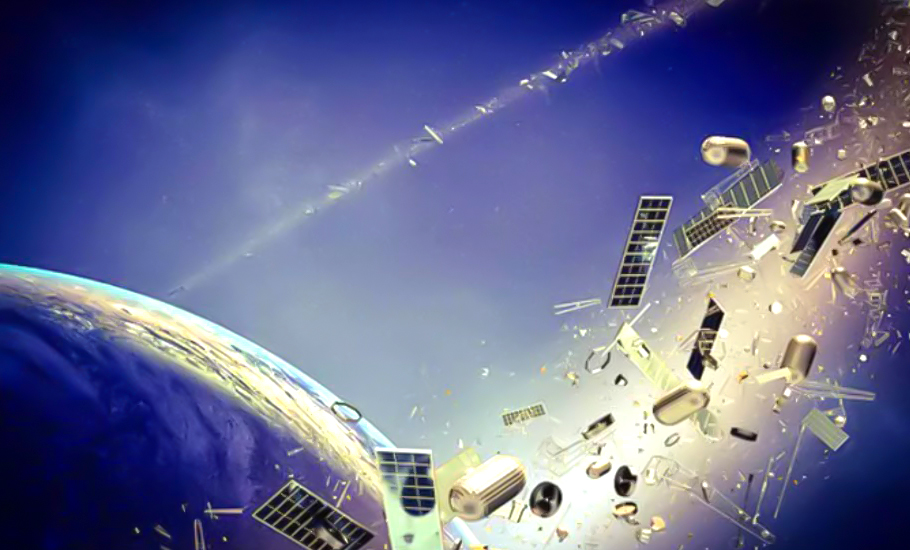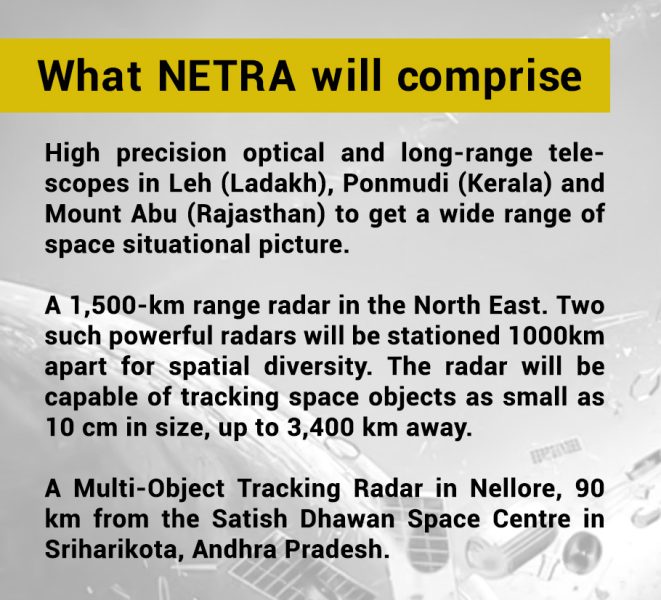
- Home
- News
- Analysis
- States
- Perspective
- Videos
- Education
- Entertainment
- Elections
- World Cup 2023
- Features
- Health
- Budget 2024-25
- Business
- Series
- NEET TANGLE
- Economy Series
- Earth Day
- Kashmir’s Frozen Turbulence
- India@75
- The legend of Ramjanmabhoomi
- Liberalisation@30
- How to tame a dragon
- Celebrating biodiversity
- Farm Matters
- 50 days of solitude
- Bringing Migrants Home
- Budget 2020
- Jharkhand Votes
- The Federal Investigates
- The Federal Impact
- Vanishing Sand
- Gandhi @ 150
- Andhra Today
- Field report
- Operation Gulmarg
- Pandemic @1 Mn in India
- The Federal Year-End
- The Zero Year
- Premium
- Science
- Brand studio
- Home
- NewsNews
- Analysis
- StatesStates
- PerspectivePerspective
- VideosVideos
- Entertainment
- ElectionsElections
- Sports
- Loading...
Sports - Features
- Budget 2024-25
- BusinessBusiness
- Premium
- Loading...
Premium

Eye in the sky: How ISRO’s NETRA will avert disasters for India’s space assets

On October 18 2021, ISRO’s Chandrayaan-2 was close to colliding with NASA’s Lunar Reconnaissance Orbiter (LRO). Both the orbiters were circling the moon around its poles. As the space agencies closely monitored the paths of the probes, they realised that their orbits were dangerously close and at a certain point the two orbits would come as close as 3 km with a mere 100 m radius...
On October 18 2021, ISRO’s Chandrayaan-2 was close to colliding with NASA’s Lunar Reconnaissance Orbiter (LRO). Both the orbiters were circling the moon around its poles. As the space agencies closely monitored the paths of the probes, they realised that their orbits were dangerously close and at a certain point the two orbits would come as close as 3 km with a mere 100 m radius separating them. If left to their current paths, the two probes would run into each other in a fatal event.
ISRO quickly responded and averted the disaster by performing the Collision Avoidance Manoeuvre (CAM), a probe control technique that diverted the course of Chandrayaan-2 at the right time.
This is not a one-off incident. Neither are such incidents few and far between. A media report states that ISRO encountered nearly 7,600 potential collision threats to its space assets in 2021; 84 were close approaches (less than 1 km) between SpaceX’s Starlink and the Indian satellites. The situation is not being faced by ISRO alone. In an escalating phenomenon, all space-faring nations are encountering such instances. The reason? Space has become crowded over the years with the increasing number of aggressive pursuits up in above the skies contributing to a rising number of space objects that could potentially collide with each other.
Continuous monitoring of the space situation and an early warning system has, therefore, become a prime necessity. Leading space-faring nations have dedicated surveillance networks called the Space Situation Awareness (SSA) programme to protect their space assets. So far, ISRO has been dependent on the US Space Command for its SSA requirements and timely alerts.
However, ISRO is kickstarting a self-reliant scheme with the NEtwork for space object TRacking and Analysis (NETRA) project to create a path to establish a homegrown space awareness programme.
Guarding the skies
ISRO is the sixth leading space-farer globally and maintains a large fleet of satellites — 15 communication satellites, 13 remote sensing satellites and eight navigation satellites. Although ISRO has been closely monitoring and analysing its space assets for the past few decades, a dedicated system to tackle the growing space challenges was lacking. Recognising the need for a rigorous monitoring facility that keeps an eye out for potential threats to space assets, the Directorate of Space Situational Awareness and Management (DSSAM) was established at ISRO in 2019.
The NETRA project was initiated under the DSSAM agenda. On December 14, 2020, Dr K Sivan, the then chairman of ISRO, formally inaugurated the SSA Control Centre at the ISTRAC campus in Peenya, Bengaluru. The centre will have state of the art facilities dedicated to SSA activities on a par with international agencies.

“The Directorate engages in evolving improved operational mechanisms to protect Indian space assets through effective coordination amongst ISRO/DOS (Dept of Space) Centres, other space agencies and international bodies, and the establishment of necessary supporting infrastructures, such as additional observation facilities for space object monitoring, and a control centre for centralised SSA activities,” a ISRO statement on the organisation’s website reads.
The ever-increasing space debris
Catastrophic events need not occur only when spacecraft collide. The space has been swarming with objects over the years, and the chances of satellites crossing paths with other space objects are rife. Moreover, a satellite can be damaged irretrievably by random space debris – natural or human-made.
Although space indicates emptiness, several surprise natural visitors pass by from time to time — meteors, wandering asteroids, space dust and debris. In addition, ever since humans ventured into space, we have added more than 7,000 tonnes of junk to space. Leftover rocket parts, defunct or lost satellites, and small items like screws, bolts and tools accidentally lost to space, improperly decommissioned satellite parts constitute space debris which has been growing over the years.
Such fragments float around in space at dangerous speeds of nearly 30,000 km/hour. A collision with any of these – even a fleck of worn-out paint – can turn fatal for functioning satellites.
ISRO notes that the number of collision avoidance manoeuvres they carry out is growing each year due to the increasing number of space missions globally. For example, they employed 60 CAM between 2015 and 2021, whereas 2021 alone called for 19 manoeuvres.
Moreover, space debris is a serious concern during satellite launches, and the agency painstakingly monitors the skies for potential objects that could collide with the rockets. There is also an escalating concern about space warfare and anti-satellite missiles, which must be factored into observations.
What project NETRA will do
Being built at an estimated cost of Rs 400 crore, project NETRA is a ground-based observational system and will have several indigenously designed and built tracking systems.
Initially, NETRA will scan satellites in low earth orbit (150-2,000 km), later expanding to geosynchronous orbit (up to 36,000 km in space). Eventually, ISRO plans to add a dedicated satellite telescope to track other satellites in space like the advanced nations.

Currently, ISRO’s various centres spread across the country keep track of the space debris. With NETRA, they will all come under one roof at the SSA centre, which will become the central hub for tracking all activities within India. AI-powered data processing units will continuously coordinate the data from the telescopes and radars to monitor the space assets.
Towards self-reliance
NETRA comes under the Atmanirbhar Bharat initiative. Establishing the SSA Control Centre is an important milestone for ISRO and India which will enhance and augment the country’s space situational awareness capabilities.
Apart from watching out for potential collisions, SSA has a broad spectrum of activities listed under its areas of implementation.
ISRO identifies them as:
• Close approach analysis between ISRO’s satellite and launch vehicles,
• Timely dissemination of advance alerts on upcoming critical conjunctions (collisions) for collision avoidance of operational assets,
• Predicting atmospheric re-entry of derelict satellites and rocket bodies.
In addition, ISRO proposes to set up dedicated labs in the control centre for space debris mitigation and remediation, compliance verification of Inter-Agency Space Debris Coordination Committee guidelines and various R&D activities. The R&D activities will include space object fragmentation and break up modelling, space debris population and micrometeoroid environment modelling, Space Weather studies, Near-Earth Objects and planetary defence studies.
By this year-end, Prime Minister Narendra Modi will sign a Memorandum of Understanding with his US counterpart President Joe Biden. According to the agreement, NETRA will collaborate with Combined Space Operation Center – a US-led multi-national initiative – for shared services. There will be an exchange of data on the potential threat to satellites and other space assets between the two nations, not only from space debris but from other hostile military activities.

